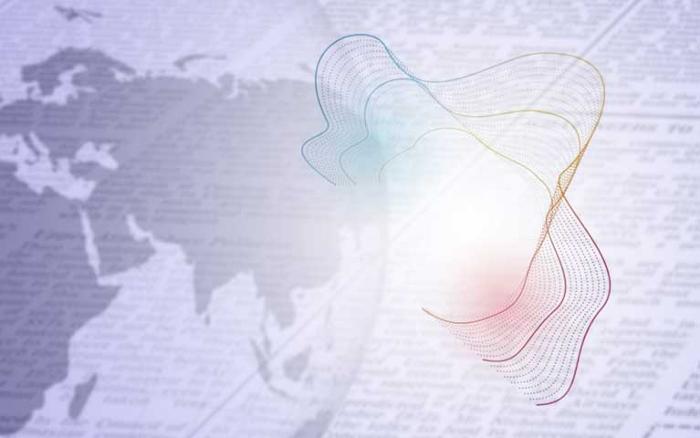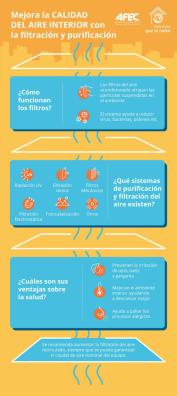

Air Purification Can Prevent Many Infections
According to the World Health Organisation, we spend 90% of our time indoors, and nine out of ten people indoors breathe highly polluted air. Find out why room ventilation and air quality are so important, especially during a pandemic like this one.
Depending on building type, air pollution, and outside noise levels, natural ventilation may not be enough to ensure adequate ventilation. “For these reasons, mechanical ventilation is the optimal solution for providing controlled, efficient and healthy intake of outside air” affirms Samuel Casado, Head of the Studies and Legislation Department of the Association of Air Conditioning Equipment Manufacturers (AFEC).
However, various factors mean that “sometimes it’s not feasible to achieve adequate ventilation, so we need to incorporate extra air filtration or purification systems such as HEPA filters, UVC lamps, or photocatalytic systems” These kinds of systems can prevent many infections.
HEPA filters are widely proven to be effective, as they are the ones used in cleanroom filtration. They have a filtration efficiency of at least 99.95% for the most penetrating particle sizes (MPPS). “These types of absolute filters provide a physical barrier that stops droplet nuclei, mould spores, viruses and bacteria, ensuring that they are filtered out regardless of particle size.”
Electrostatic Filtration
There are also other systems with proven effectiveness, such as “electrostatic filtration, which can catch up to 98% of MPPS particles, stopping and eliminating bacteria and viruses, without increasing motor power” Electrostatic filters can be installed in airboxes, ducts, grilles, diffusers, fan coils and ATUs.
Casado points out that, also, ultraviolet light purification and sterilisation technology is recommended for closed rooms, inside HVAC equipment itself or in ventilation ducts, as well as in portable air purifiers. “They only treat the air at low speed within the light’s radius of action; special precautions are needed to protect people from direct radiation.”
Finally, he emphasises that we should not forget photocatalytic purification systems, which are suitable for eliminating viruses, bacteria, fungi, and odours, as well as ethylene and volatile organic compounds.
Additional Measures
There’s also a reminder from the Spanish Technical Association of Air Conditioning and Refrigeration (ATECYR): Although air filtration and purification improve indoor air quality. So they are recommended for preventing contagion, the best way to avoid virus transmission by aerosols as much as possible is ventilation with outside air to dilute it. “When there is a contagious person in the room, the more outside air (assuming it’s free of SARS-CoV-2) that is drawn in, the less concentrated the contaminant will be; in other words, the virus concentration in the space will be the lower, and so will the contagion risk for the other occupants.”
So, filtration and purification measures “should be an alternative or additional measure where the outside air ventilation flows recommended to prevent infection can not be achieved. ”At ATECYR “we recommend a minimum of 12.5 litres per second per occupant.”
As for the use of filters, they point out that all of them will help to a greater or lesser extent to eliminate the concentration of viruses. “Although the virus size is about 0.1 microns, it’s not found isolated in the air in isolation. Rather it spreads in aerosols, which can vary greatly in size depending on what the infected person is doing (breathing, talking, singing, sneezing and so on); the aerosols are never more than 10 microns.”
Efficient Systems
So, any HVAC system that filters particles as small as ten microns can be effective. “When bioaerosols enter the body, only those smaller than one micron can reach the lower airways (lungs and pulmonary alveoli). So, a minimum filtration level of 50% to ISO 16890 must be guaranteed for particle sizes between 0.3-1 microns (ePM1-50%).”
When installing filters, “it’s essential to ensure that they are installed correctly and that the fans can overcome the pressure drop that higher efficiency filters generate.”
And portable air purifiers can be an alternative if ventilation capacity is limited. These purifiers have to be selected correctly, to satisfy at least the following criteria: reduce risk by using HEPA filters alone (they remove over 99.95% of aerosols in an air flow passing through them); use equipment certified by accredited or reputable bodies; suitable size for the space to be protected, with at least five air changes an hour; place the purifier in the middle of the room, and change the filter at least twice a year. Always change them using the required safety measures (wearing a mask and gloves and placing used filters in a sealed plastic bag before disposal).
Second Wave of Covid
A recent university research study warns of the importance of home ventilation during the second wave of Covid-19. The paper warns that “current health measures are failing to address a key element: air quality in homes” It concludes that “failure to do so may have serious consequences in the current situation.”
The authors are Professor Roberto Alonso González Lezcano of the Higher Polytechnic School of the CEU San Pablo University, the researcher at the same centre, Sonia Cesteros, and professors Samuel Domínguez and Jessica Fernández-Agüera of the University Institute of Architecture and Construction Sciences of the University of Seville. Their article is titled: Bad Air Can Also Kill: Residential Indoor Air Quality and Pollutant Exposure Risk during the COVID-19 Crisis, published in the International Journal of Environmental Research and Public Health.





